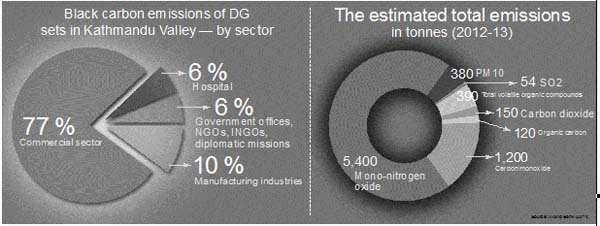Diesel generator emissions making Valley air more toxic
KATHMANDU, July 27
With loadshedding becoming a perennial problem, Nepal’s dependency on diesel generators has massively increased to meet the power demand. From industrial and commercial to non-commercial sectors, diesel generator (DG) sets, which are a short-term solution, seem to be the only option, but they can have long-term health effects.
The use of diesel generators in Kathmandu has reached highest since 2006, with manufacturing industries, commercial sectors, hotels, hospitals, government organisations, NGOs, INGOs and diplomatic missions heavily relying on them during power outage, which during dry season could reach 12 hours a day.
Black carbon emitted by diesel generators is adding to already polluted Kathmandu air, say stakeholders.
According to a study by the World Bank in 2014, the total estimated amount of black carbon emission from various sectors in Kathmandu Valley in 2012-13 was 220 tonnes. Highest emission was recorded during dry months of December-April.
Black carbon is hazardous to human health as well as climate. Inhaling such gas might cause respiratory/cardiovascular disease, cancer and birth defects. Environmentally, it can cause disoriented rainfall pattern and global warming.
Black carbon is carcinogenic gas, said Prashanta Khanal, Programme Coordinator, Clean Energy Nepal, adding that the way ‘our dependency on diesel generators is increasing, our health is certainly at risk’.
“Black carbon is carried by the wind current to the mountains. It traps the sun’s heat causing the ice to melt in the Himalayas of Nepal,” he said, adding that around 8,000 diesel generators are used in the Valley. There are 24 major diesel generator traders in the Valley, importing more than 50 brands of generators.
Black carbon emissions have direct adverse impacts on the snow and ice, said the World Bank report. When deposited on the earth’s surface, black carbon can accelerate the melting of snow and ice, sensitive regions such as the Arctic and the Himalayas are particularly vulnerable to melting, the report said.
Nepal’s air quality was ranked 177th out of 178 countries in Yale’s 2014 Environmental Performance Index, better only than Bangladesh, all thanks to emissions of black carbon and co-pollutants like carbon monoxide, carbon dioxide and sulfur dioxide among others.
Nepal Electricity Authority has been struggling to maintain loadshedding below 12 hours a day during dry months. The estimated power supply was 1,095 MW in 2013-2014, but only 720 MW was supplied. Rest of 375 MW was covered up by the use of generators.
Kashis Das Shrestha, Director, City Museum Kathmandu, which hosts Liveable Kathmandu campaign, said, “Kathmandu’s air pollution goes up by 40 per cent during loadshedding hours. In the winter months, Kathmandu is prone to 14 to 18 hours of power outage daily. Removal of such generators that highly contribute to air pollution could be an important step towards public health, national treasury, domestic environment and energy security agenda.”
NEA predicts that loadshedding will rise up to 21 hours a day if electricity demand continued to increase.
According to Nepal Oil Corporation, around 30-40 per cent of the country’s total diesel import is being used to generate electricity during loadshedding hours.
The country has been generating about 531 MW of electricity from diesel engines. Diesel consumers have doubled in the last five years.






